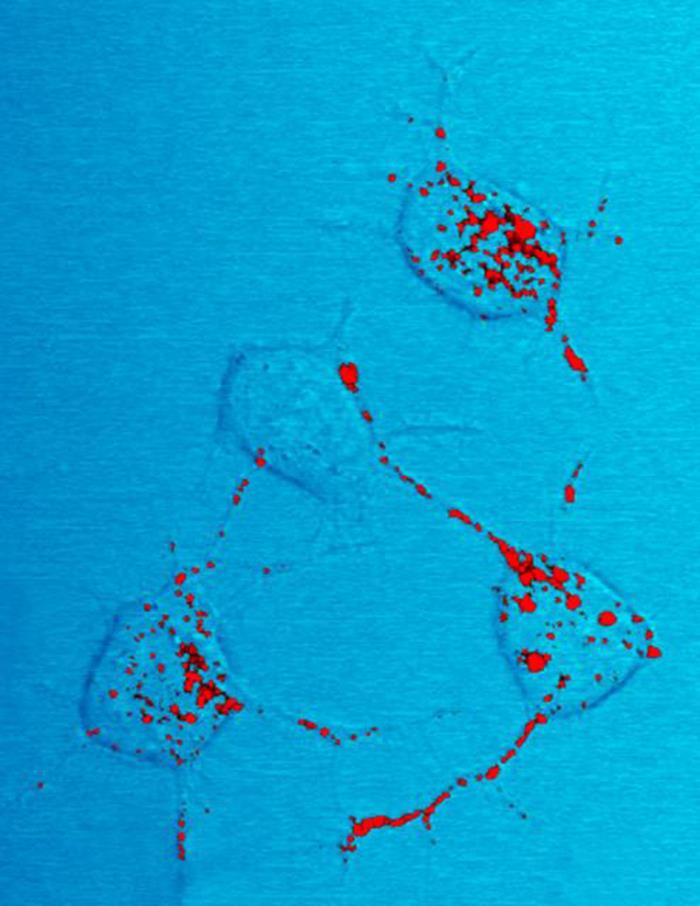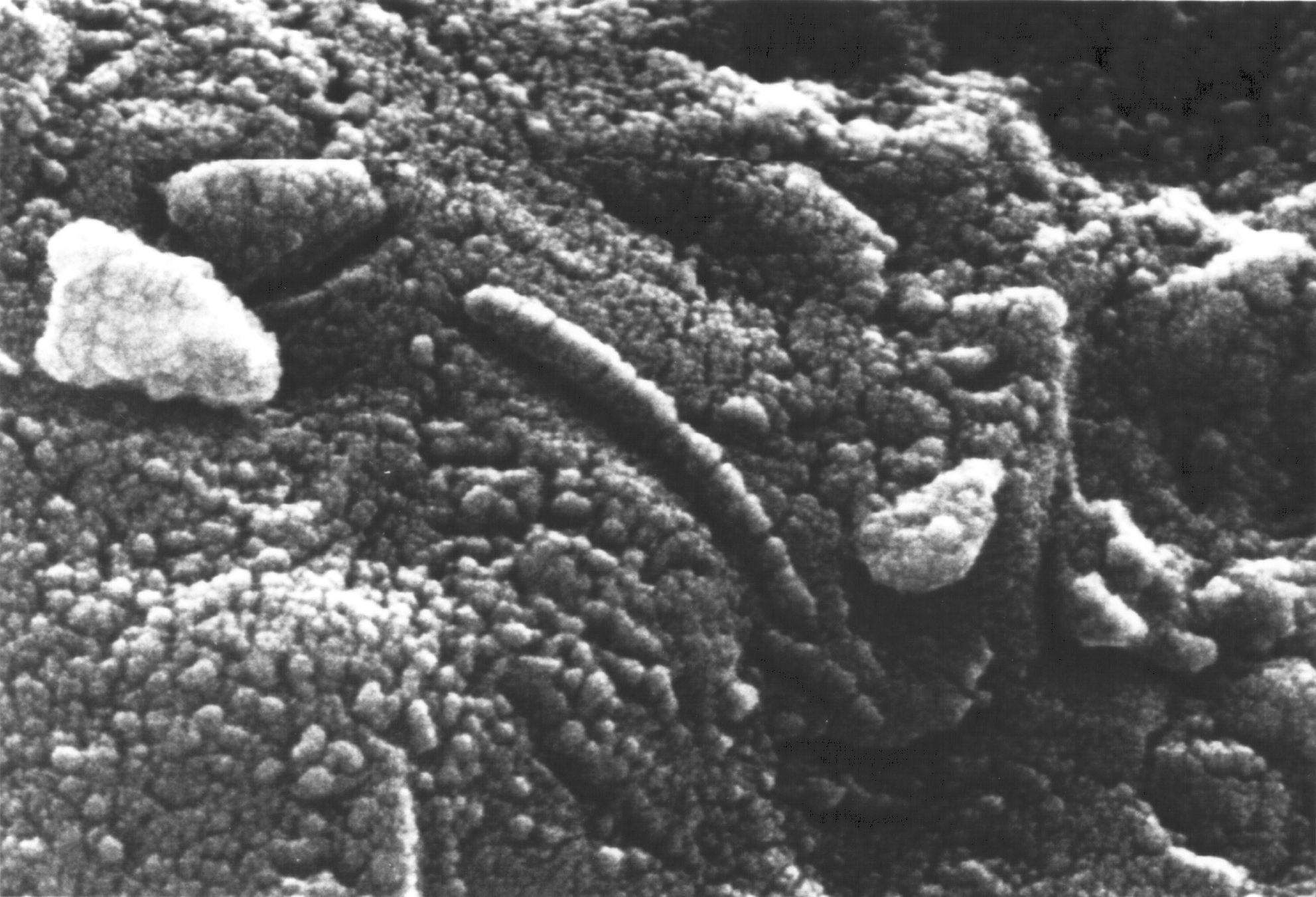|
Ultramicrobacteria
Ultramicrobacteria are bacteria that are smaller than 0.1 μm3 under all growth conditions. This term was coined in 1981, describing cocci in seawater that were less than 0.3 μm in diameter. Ultramicrobacteria have also been recovered from soil and appear to be a mixture of Gram-positive, Gram-negative and cell-wall-lacking species. Ultramicrobacteria possess a relatively high surface-area-to-volume ratio due to their small size, which aids in growth under oligotrophic (i.e. nutrient-poor) conditions. The relatively small size of ultramicrobacteria also enables parasitism of larger organisms; some ultramicrobacteria have been observed to be obligate or facultative parasites of various eukaryotes and prokaryotes. One factor allowing ultramicrobacteria to achieve their small size seems to be genome minimization such as in the case of the ultramicrobacterium '' P. ubique'' whose small 1.3 Mb genome is seemingly devoid of extraneous genetic elements like non-coding DNA, transposons, ex ... [...More Info...] [...Related Items...] OR: [Wikipedia] [Google] [Baidu] |
Bacteria
Bacteria (; singular: bacterium) are ubiquitous, mostly free-living organisms often consisting of one biological cell. They constitute a large domain of prokaryotic microorganisms. Typically a few micrometres in length, bacteria were among the first life forms to appear on Earth, and are present in most of its habitats. Bacteria inhabit soil, water, acidic hot springs, radioactive waste, and the deep biosphere of Earth's crust. Bacteria are vital in many stages of the nutrient cycle by recycling nutrients such as the fixation of nitrogen from the atmosphere. The nutrient cycle includes the decomposition of dead bodies; bacteria are responsible for the putrefaction stage in this process. In the biological communities surrounding hydrothermal vents and cold seeps, extremophile bacteria provide the nutrients needed to sustain life by converting dissolved compounds, such as hydrogen sulphide and methane, to energy. Bacteria also live in symbiotic and parasitic relationsh ... [...More Info...] [...Related Items...] OR: [Wikipedia] [Google] [Baidu] |
Nanobacterium
''Nanobacterium'' ( , pl. ''nanobacteria'' ) is the unit or member name of a former proposed class of living organisms, specifically cell-walled microorganisms A microorganism, or microbe,, ''mikros'', "small") and ''organism'' from the el, ὀργανισμός, ''organismós'', "organism"). It is usually written as a single word but is sometimes hyphenated (''micro-organism''), especially in olde ..., now discredited, with a size much smaller than the generally accepted lower limit for life (about 200 nanometer, nm for Bacteria#Morphology, bacteria, like Mycoplasma pneumoniae#Cell biology, mycoplasma). Originally based on observed nano-scale structures in geological formations (Allan Hills 84001, including one meteorite), the status of nanobacteria was controversial, with some researchers suggesting they are a new class of living organism capable of incorporating radiolabeled uridine, and others attributing to them a simpler, abiotic nature. One skeptic dubbed them "t ... [...More Info...] [...Related Items...] OR: [Wikipedia] [Google] [Baidu] |
Nanobacteria
''Nanobacterium'' ( , pl. ''nanobacteria'' ) is the unit or member name of a former proposed class of living organisms, specifically cell-walled microorganisms, now discredited, with a size much smaller than the generally accepted lower limit for life (about 200 nm for bacteria, like mycoplasma). Originally based on observed nano-scale structures in geological formations ( including one meteorite), the status of nanobacteria was controversial, with some researchers suggesting they are a new class of living organism capable of incorporating radiolabeled uridine, and others attributing to them a simpler, abiotic nature. One skeptic dubbed them "the cold fusion of microbiology", in reference to a notorious episode of supposed erroneous science. The term "calcifying nanoparticles" (CNPs) has also been used as a conservative name regarding their possible status as a life form. Research tends to agree that these structures exist, and appear to replicate in some way. However, the id ... [...More Info...] [...Related Items...] OR: [Wikipedia] [Google] [Baidu] |
Prion
Prions are misfolded proteins that have the ability to transmit their misfolded shape onto normal variants of the same protein. They characterize several fatal and transmissible neurodegenerative diseases in humans and many other animals. It is not known what causes a normal protein to misfold, but the resulting abnormal three-dimensional structure confers infectious properties by collapsing nearby protein molecules into the same shape. The word ''prion'' is derived from the term, "proteinaceous infectious particle". In comparison to all other known infectious agents such as viroids, viruses, bacteria, fungi, and parasites, all of which contain nucleic acids ( DNA, RNA, or both), the hypothesized role of a protein as an infectious agent stands in contrast. Prion isoforms of the prion protein (PrP), whose specific function is uncertain, are hypothesized as the cause of transmissible spongiform encephalopathies (TSEs), including scrapie in sheep, chronic wasting disease (CWD) ... [...More Info...] [...Related Items...] OR: [Wikipedia] [Google] [Baidu] |
Parvovirus
Parvoviruses are a family of animal viruses that constitute the family ''Parvoviridae''. They have linear, single-stranded DNA (ssDNA) genomes that typically contain two genes encoding for a replication initiator protein, called NS1, and the protein the viral capsid is made of. The coding portion of the genome is flanked by telomeres at each end that form into hairpin loops that are important during replication. Parvovirus virions are small compared to most viruses, at 23–28 nanometers in diameter, and contain the genome enclosed in an icosahedral capsid that has a rugged surface. Parvoviruses enter a host cell by endocytosis, travelling to the nucleus where they wait until the cell enters its replication stage. At that point, the genome is uncoated and the coding portion is replicated. Viral messenger RNA (mRNA) is then transcribed and translated, resulting in NS1 initiating replication. During replication, the hairpins repeatedly unfold, are replicated, and refold to chang ... [...More Info...] [...Related Items...] OR: [Wikipedia] [Google] [Baidu] |
Pandoravirus
''Pandoravirus'' is a genus of giant virus, first discovered in 2013. It is the second largest in physical size of any known viral genus. Pandoraviruses have double stranded DNA genomes, with the largest genome size (2.5 million base pairs) of any known viral genus. Discovery The discovery of Pandoraviruses by a team of French scientists, led by husband and wife Jean-Michel Claverie and Chantal Abergel, was announced in a report in the journal ''Science'' in July 2013. Other scientists had previously observed the pandoravirus particles, but owing to their enormous size they were not expected to be viruses. Patrick Scheid, a parasitologist from the Central Institute of the Bundeswehr Medical Service in Koblenz, Germany, found one in 2008, in an amoeba living in the contact lens of a woman with keratitis. Its development within the amoebal host was documented extensively. Unlike in other cases with such giant viruses, the large particles within ''Acanthamoeba'' were not mistak ... [...More Info...] [...Related Items...] OR: [Wikipedia] [Google] [Baidu] |
Pithovirus
''Pithovirus'', first described in a 2014 paper, is a genus of giant virus known from two species, ''Pithovirus sibericum'', which infects amoebas and ''Pithovirus massiliensis''. It is a double-stranded DNA virus, and is a member of the nucleocytoplasmic large DNA viruses clade. The 2014 discovery was made when a viable specimen was found in a 30,000-year-old ice core harvested from permafrost in Siberia, Russia. Description The genus name ''Pithovirus'', a reference to large storage containers of ancient Greece known as pithoi, was chosen to describe the new species. A specimen of ''Pithovirus'' measures approximately 1.5 μm (1500 nm) in length and 0.5 μm (500 nm) in diameter, making it the largest virus yet found. It is 50% larger in size than the ''Pandoraviridae'', the previous largest-known viruses, and is larger than '' Ostreococcus'', the smallest eukaryotic cell, although ''Pandoravirus'' has the largest viral genome, containing 1.9 to 2.5 megabases ... [...More Info...] [...Related Items...] OR: [Wikipedia] [Google] [Baidu] |
Nanobe
A nanobe () is a tiny filamental structure first found in some rocks and sediments. Some scientists hypothesize that nanobes are the smallest form of life, 1/10 the size of the smallest known bacteria. No conclusive evidence exists that these structures are, or are not, living organisms, so their classification is controversial. The 1996 discovery of nanobes was published in 1998 by Philippa Uwins ''et al.'', from the University of Queensland, Australia. They were found growing from rock samples (both full-diameter and sidewall cores) of Jurassic and Triassic sandstones, originally retrieved from an unspecified number of oil exploration wells off Australia's west coast. Depths of retrieval were between and below the sea bed. While Uwins ''et al.'' present assertions against it, they do not exclude the possibility that the nanobes are from a surface contaminant, not from the rock units cited. The smallest are just 20 nanometers in diameter. Some researchers believe that ... [...More Info...] [...Related Items...] OR: [Wikipedia] [Google] [Baidu] |
Mycoplasma
''Mycoplasma'' is a genus of bacteria that, like the other members of the class ''Mollicutes'', lack a cell wall around their cell membranes. Peptidoglycan (murein) is absent. This characteristic makes them naturally resistant to antibiotics that target cell wall synthesis (like the beta-lactam antibiotics). They can be parasitic or saprotrophic. Several species are pathogenic in humans, including '' M. pneumoniae'', which is an important cause of "walking" pneumonia and other respiratory disorders, and '' M. genitalium'', which is believed to be involved in pelvic inflammatory diseases. ''Mycoplasma'' species (like the other species of the class ''Mollicutes'') are among the smallest organisms yet discovered, can survive without oxygen, and come in various shapes. For example, ''M. genitalium'' is flask-shaped (about 300 x 600 nm), while ''M. pneumoniae'' is more elongated (about 100 x 1000 nm), many ''Mycoplasma'' species are coccoid. Hundreds of ''Mycoplasma'' species i ... [...More Info...] [...Related Items...] OR: [Wikipedia] [Google] [Baidu] |
L-form Bacteria
L-form bacteria, also known as L-phase bacteria, L-phase variants or cell wall-deficient (CWD) bacteria, are growth forms derived from different bacteria. They lack cell walls. Peptidoglycan (murein) is absent. Two types of L-forms are distinguished: ''unstable L-forms'', spheroplasts that are capable of dividing, but can revert to the original morphology, and ''stable L-forms'', L-forms that are unable to revert to the original bacteria. Discovery and early studies L-form bacteria were first isolated in 1935 by Emmy Klieneberger-Nobel, who named them "L-forms" after the Lister Institute in London where she was working. She first interpreted these growth forms as symbionts related to pleuropneumonia-like organisms (PPLOs, later commonly called mycoplasmas). Mycoplasmas (now in scientific classification called ''Mollicutes''), parasitic or saprotrophic species of bacteria, also lack a cell wall (peptidoglycan/murein is absent).&nbsFull PDF/ref> Morphologically, they resemble L- ... [...More Info...] [...Related Items...] OR: [Wikipedia] [Google] [Baidu] |
Dormancy
Dormancy is a period in an organism's life cycle when growth, development, and (in animals) physical activity are temporarily stopped. This minimizes metabolic activity and therefore helps an organism to conserve energy. Dormancy tends to be closely associated with environmental conditions. Organisms can synchronize entry to a dormant phase with their environment through predictive or consequential means. Predictive dormancy occurs when an organism enters a dormant phase ''before'' the onset of adverse conditions. For example, photoperiod and decreasing temperature are used by many plants to predict the onset of winter. Consequential dormancy occurs when organisms enter a dormant phase ''after'' adverse conditions have arisen. This is commonly found in areas with an unpredictable climate. While very sudden changes in conditions may lead to a high mortality rate among animals relying on consequential dormancy, its use can be advantageous, as organisms remain active longer and are ... [...More Info...] [...Related Items...] OR: [Wikipedia] [Google] [Baidu] |



